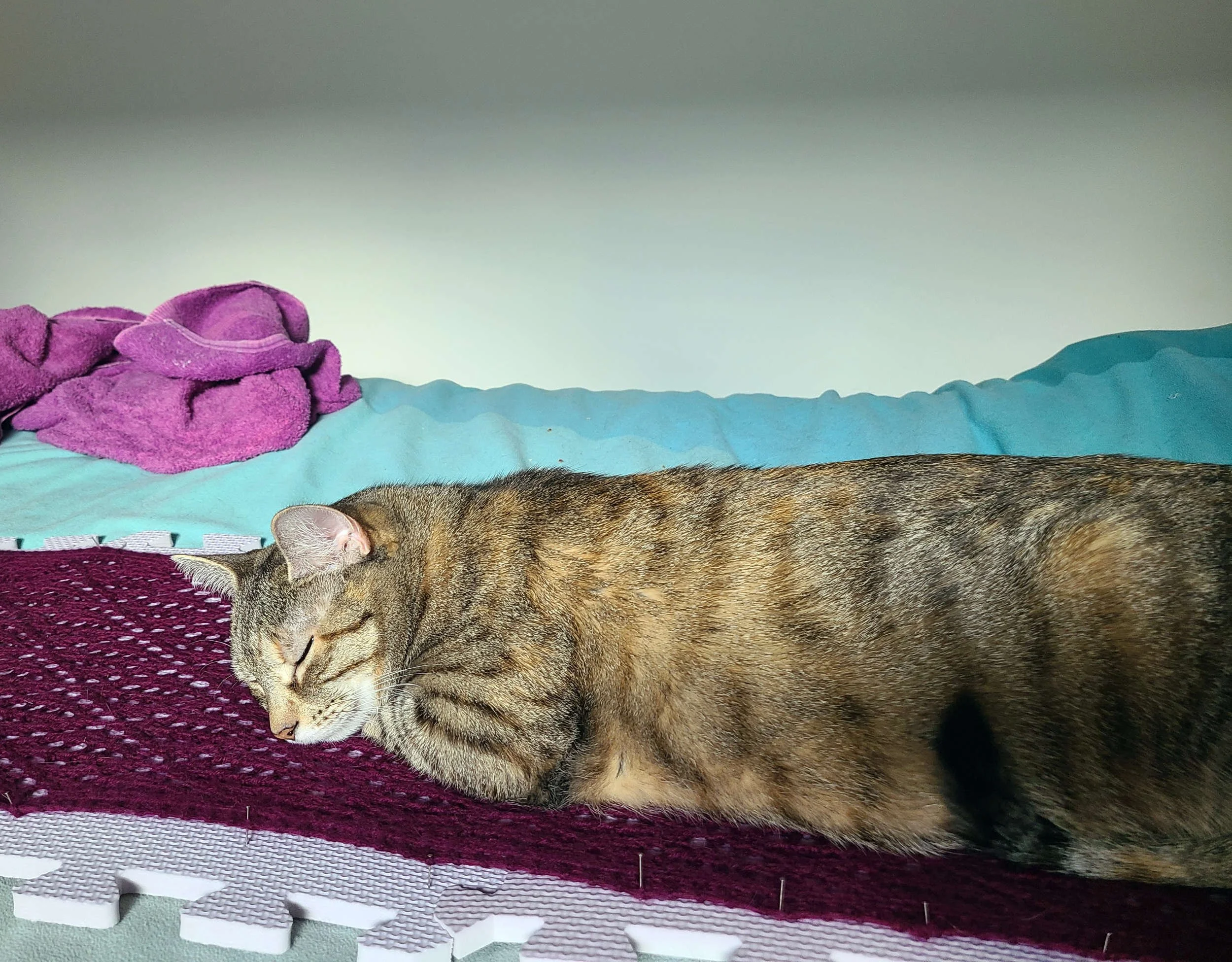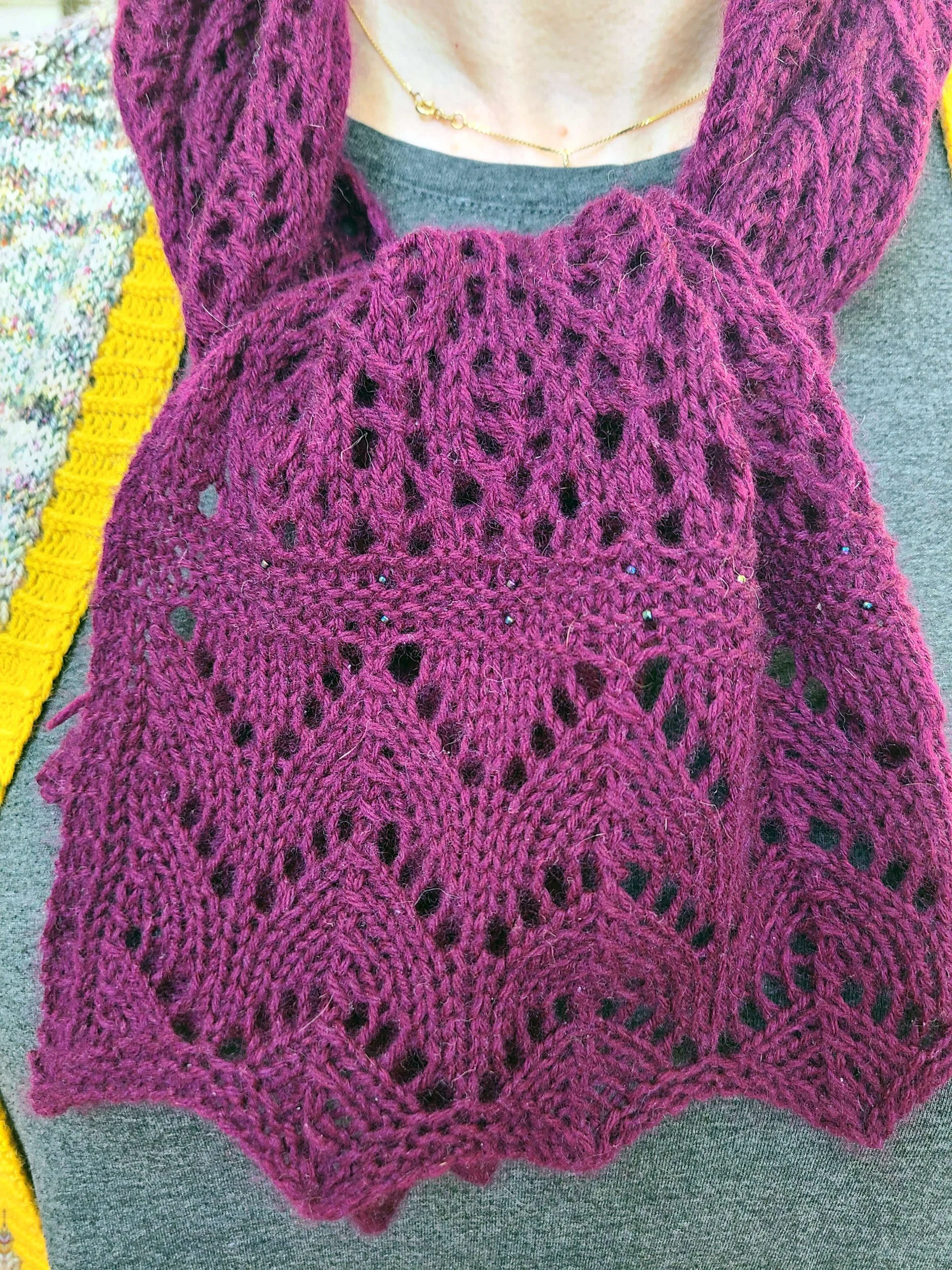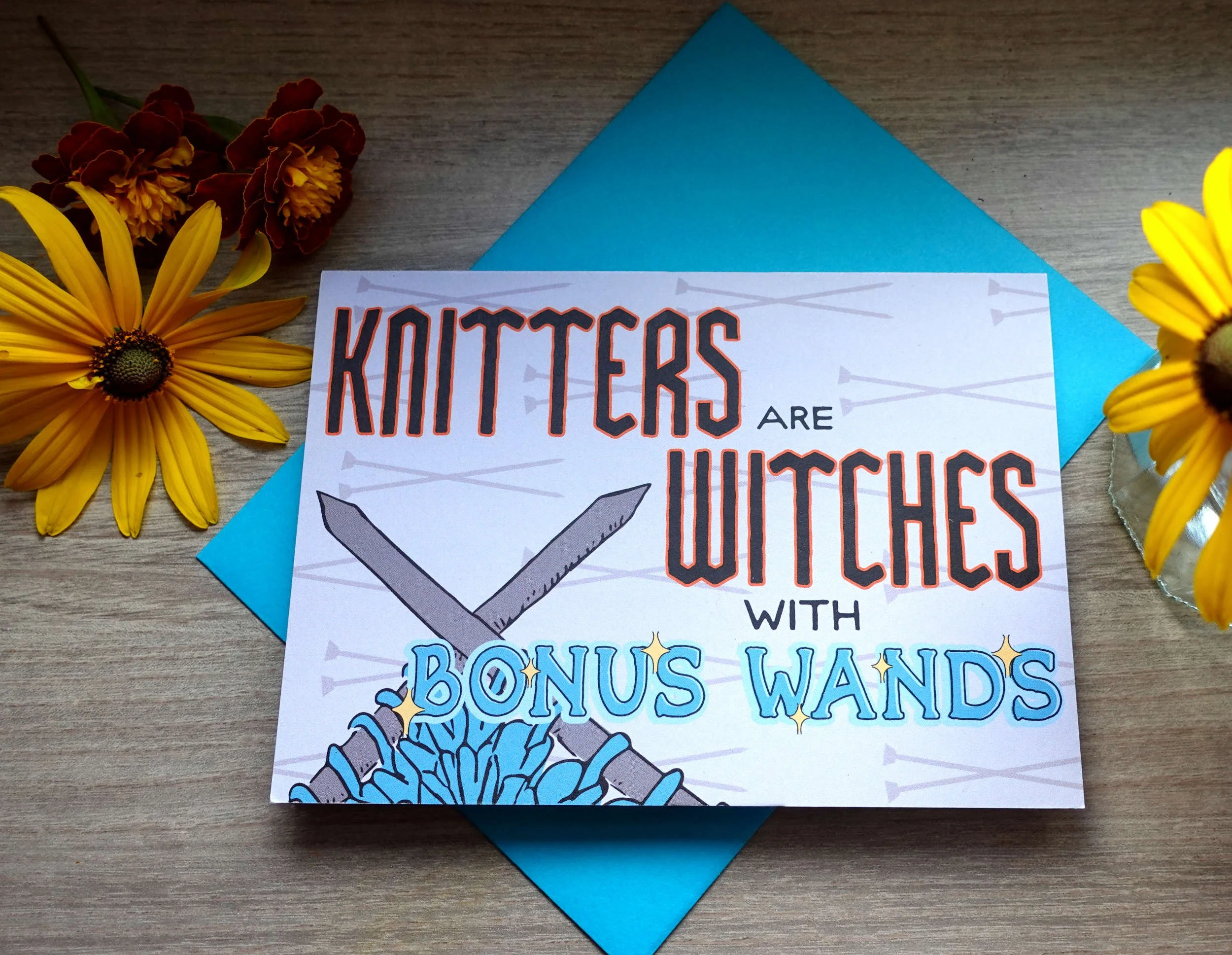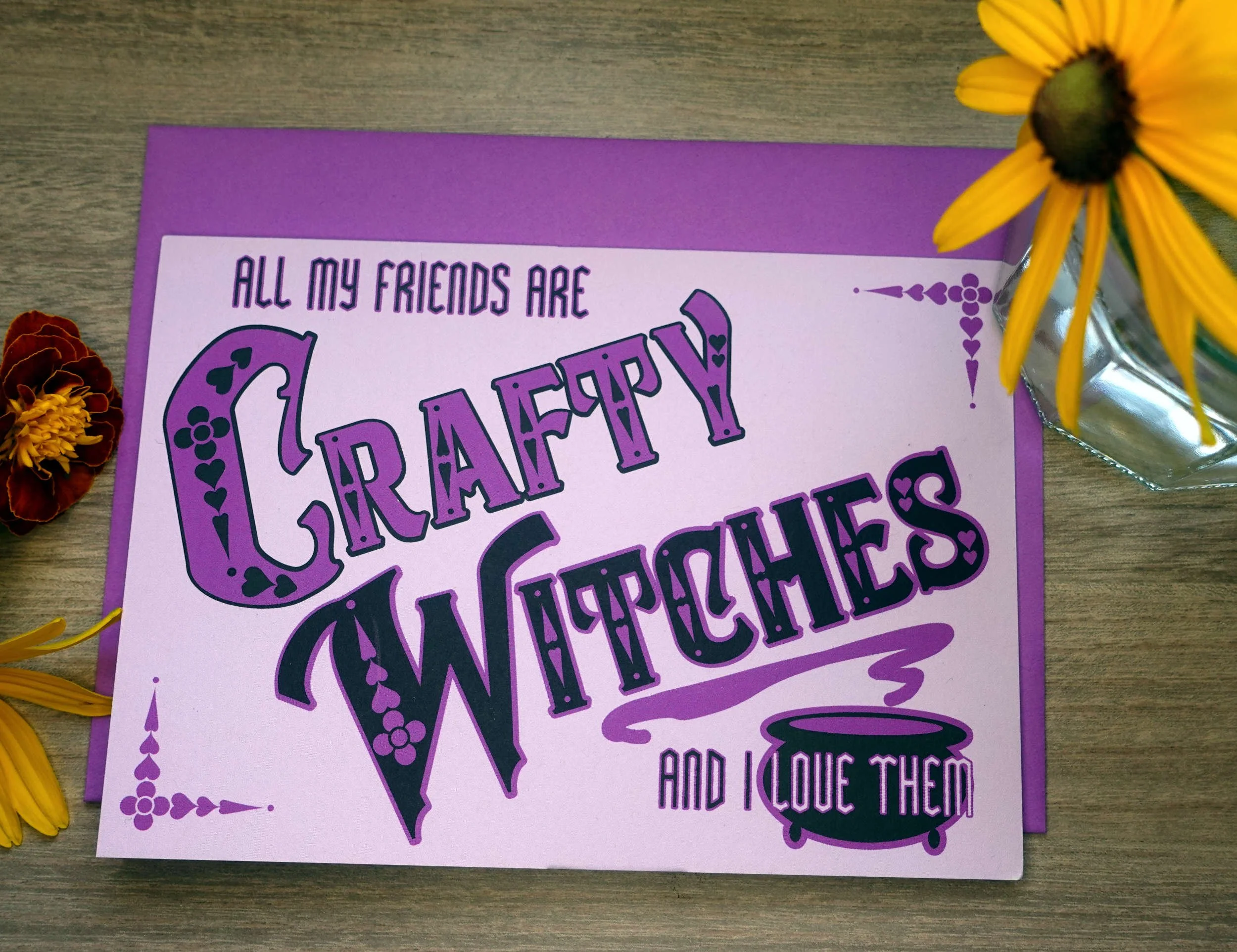The FOlio: The Kernel Scarf
In the FOlio, I reflect on a finished knitting object and what the process of knitting it taught me.
Pattern : Kernel (FREE Knitty pattern)
Designer: Bonnie Sennott/Blue Peninsula Knits (website link)
Yarn Used : Knit Picks Capretta in Elegant (discontinued – I’m linking to the new version of Capretta, which is superwash, but this was the older, non-superwash version)
Knit from : Late 2016 to February 2017 and then finished in October 2025
Lesson: You CAN finish that long-languishing WIP, you just might need a little creativity.
As I try to wind up my crafting goals for the year, I’ve been going through the WIPs that traveled with us in our last move and finally making some frog or finish decisions. I initially thought my Kernel Scarf was a definite frog. You see, the reason I never finished this scarf in the first place is that my last skein of yarn went missing after Knit Picks discontinued the colorway. Although *how* it went missing is quite a story.
I started this scarf in late 2016, I think; for some reason I never started a Ravelry project for it, but I remember knitting on it during a visit home that December. In February 2017, we had a fire in our apartment building. Although we were lucky and didn’t have any fire damage directly to our apartment, the building was declared structurally unsound and our belongings all had to be moved out and professionally cleaned due to smoke damage. This took almost three months, during which time we lived with a handful of items in our new apartment. By the time we got our stuff back and unpacked and I started looking for this scarf, the last ball of yarn I had purchased had disappeared.
For years I thought I’d just lost the whole second ball somehow, but in looking at the WIP recently, there was clearly a set of loose ends only a few inches before the end of the work, indicating I’d already joined that second ball. I now suspect that the business that cleaned our stuff cut the ball of yarn off so it wouldn’t tangle and then lost it. (They also lost an entire box of items from our living room and felted a couple of my handknit hats and gloves because they didn’t wash them properly so they weren’t the greatest.) But since that color of Capretta was now discontinued, and I’d only worked 15 repeats of the 23 called for in the pattern (not to mention the entire upper edge was missing), I wasn’t sure what to do next.
I tried both contacting Knit Picks (just in case they had one random ball somewhere) and messaging someone on Ravelry who had a ball in their stash, but nothing turned up. Because it was such a small amount of yarn there wasn’t a lot of urgency for me to frog it and turn it into something else, either. So it just sat and waited.
But we’re now in the era of the Sophie Scarf and other cute, shorter scarves. And when I pulled the WIP out this time for assessment, I realized that if I unraveled enough of the scarf to knit an upper edging, I could make a mini scarf version of Kernel.
First, I had to track down the pattern – as noted above I hadn’t made a Ravelry project for this and I didn’t initially remember the name of the pattern, but I knew it had been a Knitty pattern. A moment of praise for Knitty and their twenty plus years of free archives . All I did was filter for scarf patterns, start scrolling, and in five minutes I’d found Kernel.
Upon reviewing the pattern again, I realized Kernel was ideally suited to the alteration I wanted to make. Since the final edging of the scarf was knit separately and grafted on, all I needed to do was figure out how far I needed to unravel the scarf to get enough yarn for the edging and then I could cut the yarn and wash it to relax the kinks from the previous stitches before starting the edging. (When reusing yarn, washing it, or at least getting it damp and winding it on a swift or niddy noddy to stretch it back straight will give you a much better result when you knit it again.)
The first edging (pictured above) was not quite 5 inches long, but I suspected it would take more yarn to knit than the lacy body pattern (especially to have enough yarn for grafting). So since the body chart was supposed to end on row 15 of a repeat and I had stopped knitting in the middle of a repeat, I decided to back up 2.5 repeats, which was roughly 6 inches, and hope that would do it.
I couldn’t do a full emergency line, but I did stick my needle in the row where I meant to stop, so that I wouldn’t pull out too much.
As I unraveled, I wound the yarn up in a ball just to keep it from tangling. Since the pattern alternated lace rows and knit rows, I made sure I stopped unraveling on a knit row so it would be easier to pick up the stitches (I *have* picked up YOs before, but it’s not fun).
My best tip for picking up live stitches in a situation like this is to pick up as many as you can on the tip of the needle and only let them slide further down when they won’t accidentally pull on the stitches that haven’t been picked up yet.
After I got everything picked up, I somehow had one too many stitches! I must have made a mistake immediately before I stopped knitting. I did need to knit that final row 15, and luckily the extra stitch was in the first few stitches of the row, so it was easy enough to throw an extra decrease in and keep everything aligned.
Once I finished knitting, I cut the yarn and got out my niddy noddy to wind the loose yarn onto, then I got the yarn nice and wet and left it to dry.
I also had to go find the beads that I’d used on the first edge! A few years back I organized my craft supplies and put all my beads in a specific tea tin, so I knew that’s where they had to be. Because they were so tiny I was pretty sure I hadn’t used them up in other projects (I mostly use beads for my tea towel calendars but those beads are about 4 times the size), and sure enough, there they were!
Once the yarn was dry, I got back to work. The trickiest part was figuring out which size needles I had been using before – since this project had been sitting around for nine years I of course had swapped out the original needle because I needed it for another project. Usually when I’m knitting accessories I use the suggested needle size from the pattern so I went with that and hoped it would work.
The other tricky part was trying to remember how I put on the beads. The pattern suggests using the crochet hook method, but when I didn’t have a crochet hook tiny enough for my beads I looked closer at the beads on the other end and suddenly remembered that I had used Laura Nelkin’s bead stringing technique (I don’t have any dental floss as she uses in that video, but a loop of sewing thread on a needle small enough to fit through the beads was an effective replacement). This is a particularly great method for a small amount of tiny beads. Once that obstacle was figured out it was very easy to finish up the edging, graft it on, and then all that was left to do was block it!
Someone decided to help get the scarf nice and flat.
The beads are very subtle, and you don’t necessarily need them, but it’s a fun extra detail.
(BTW, if you’re curious about the sweater, this is the Aurea cardigan by Pip and Pin, although I added the contrast trim myself.)
I’m really happy with how this turned out, and it feels great to have found a solution to save a WIP that seemed like it would be unfinishable.
If you have any WIPs that have been languishing for lack of yarn, I hope this FOlio inspires you to take another look at it and see if there’s a way to finish it after all. Or, if you’ve done something like this yourself, tell me about it in the comments!













